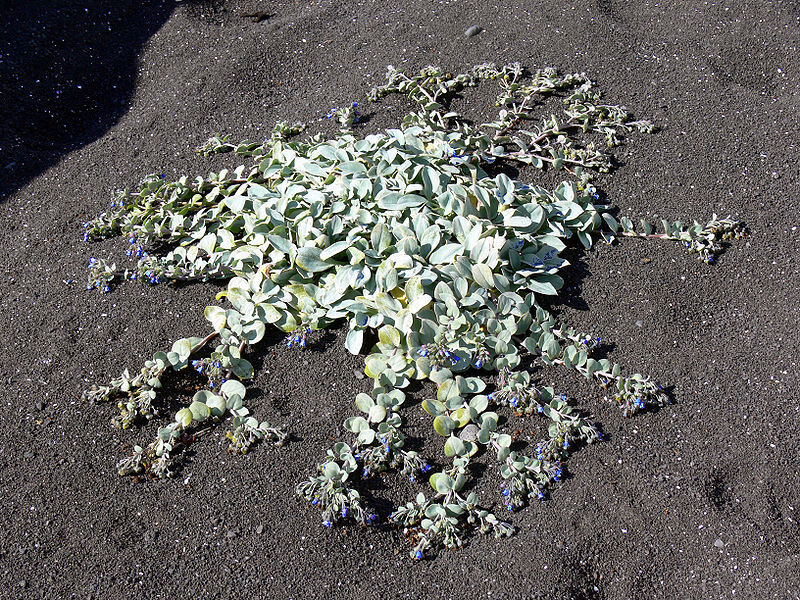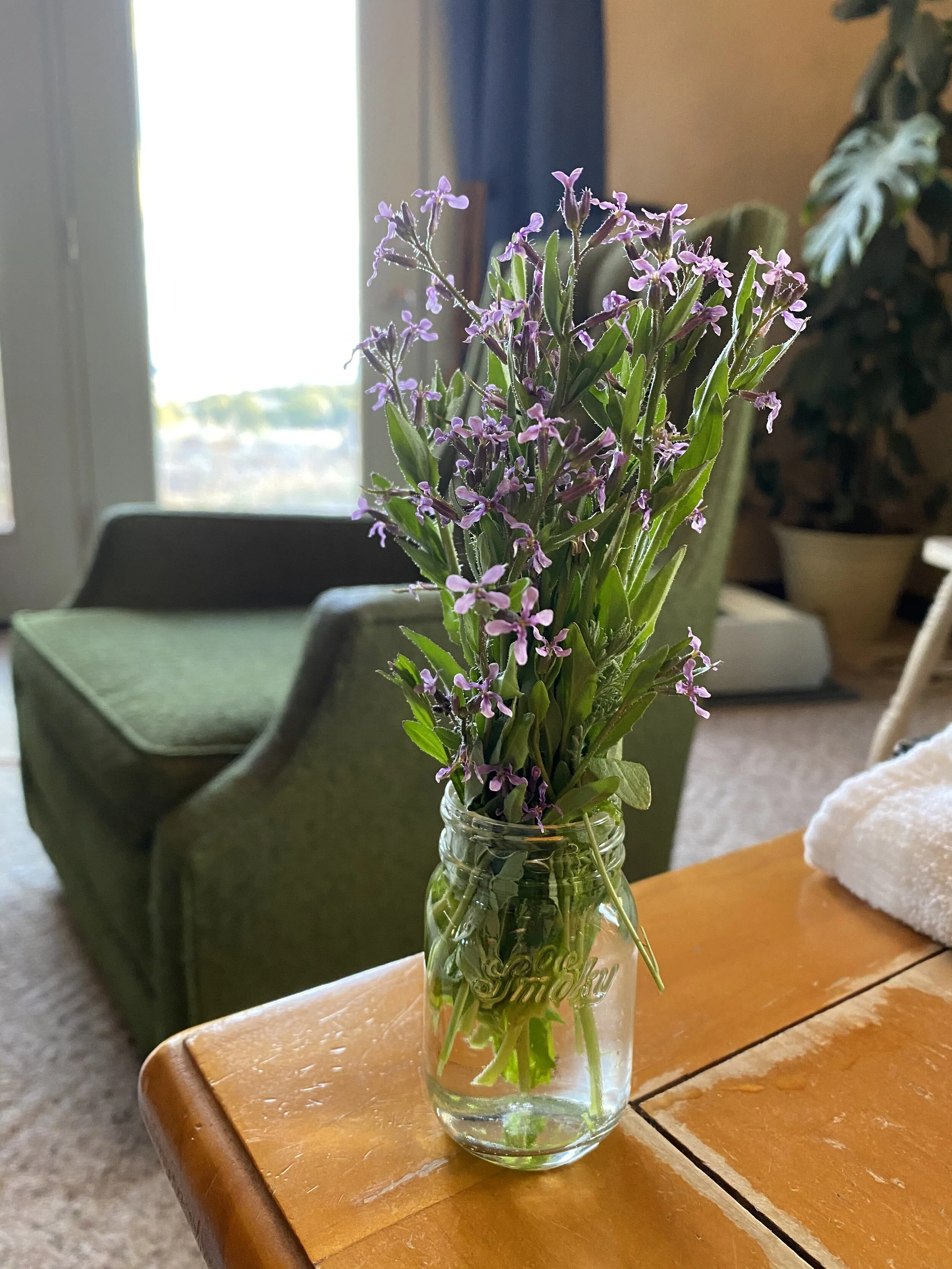The Oyster Leaf: Where the Seas Tear Savagely at the Land
Silk666 / CC BY-SA (https://creativecommons.org/licenses/by-sa/3.0)
You wake up naked and clinging for life where the ocean meets the land. You are being battered by vicious winds as salt-water waves smash your tender legs into the sharp rocks. You aren’t sure where you are. Are you in New England, Greenland, Alaska, Canada, Ireland… Russia? You are freezing and haven’t had a drink of fresh water or eaten in days, but you are no ordinary Jack washed up and dying on the shore, are you? No!
Today is just another day in the neighborhood. That’s right; you are Mertensia maritima, and you’re a total psycho because—for some reason or another—this is where you prefer to live.
You also happen to be a tasty vegetable that prefers to store its energy in the form of fat rather than starch [1].
Oooof! Our World is amazing, isn’t it?
Welcome to the edge of the tempest, where the seas tear savagely at the land, and the winds scream the curses of Poseidon. Welcome to the world of Mertensia maritima:
The Oyster Leaf!!!
Mertensia maritima
Family — Boraginaceae
Aliases — Ice Plant, Northern Shorewort, Oyster Leaf, Sea Bluebells, Sea Bugloss, Sea Gromwell, Sea Lungwort, Sea Mertensia, Vegetarian Oyster; 滨紫草 (Chinese); Hestetunge {meaning: Horse’s tongue} (DANISH); Ciunertur Pag (CUP'IG); Merihalikka (FINNISH); Huître Potagère, Huître Végétale, Pulmonaire de Virginie, Sanguine de Mer (FRENCH); Blauglöckchen, Seestrandlungenkraut (GERMAN); Blálilja (ICELANDIC); Akulurungnuit (IñUPIAQ); Hamabenkeiso (JAPANESE); Østersurt (NORWEGIAN); мертензия морская (RUSSIAN); Ostronört (SWEDISH); Ciunerturpat, Neqnirliar {meaning: delicious}, Tumaglir (YUP'IK).
Binomial Etymology — Mertensia is a name honoring Franz Carl Mertens (1764-1831).
Binomial Synonyms: —Pulmonaria maritima, Lithospermum maritimum
Description
The small, five-petaled flowers of Mertensia martima present in terminal clusters appearing as pink buds when closed and vibrant blue when opened. The stems creep prostrate upon the ground and curve upward toward the sky at the apex. Its leaves are alternate, succulent, broadly ovate, and grayish-green [1].
Christian Bickel / CC BY-SA 2.0 DE (https://creativecommons.org/licenses/by-sa/2.0/de/deed.en)
Habitat
Oyster Leaf occurs at sub-attic shorelines near the high tide mark among the rocks [1].
Culinary Uses
An individual of the YUPIK tribe, who resided on Nelson island on the Southwestern coast of Alaska in 1980, reported that the long succulent stems were placed in cold water, brought to a brief boil, and were served with seal oil. The name she used for the plant was reportedly neqnirliar, meaning, delicious [2].
The CHAPLINSKI YUPIK (residing on Russia’s far east coast) ferment and preserve the leaves and stems for later use [3]. I hope to try this one day.
Most every reference asserts that the leaves taste identical to oysters.
Ethnobotany
You can bet your last can of beans that any colloquial name including the name “wort” was almost invariably known by protoscientists of antiquity as a medicine. The name “lungwort” strongly suggests that this plant was—at one time, at least— known to treat ailments of the lungs. Reasonable enough.
It turns out that the Mertensia genus was once considered a species of Pulmonaria (aka Lungworts), which, where used generally as remedies for diseased lungs on account of their tendencies to have white-spotted leaves [7]. I am left to blindly assume this was related to the Doctrine of Signatures somehow. It appears, however, that this is a power that never translated specifically to Mertensia maritima… even back when it went by its maiden name: Pulmonaria maritima.
Mertensia maritima, eaten as a salad green, was thought by Native peoples of the Aleutian Islands of Alaska to ward off scurvy [5]. It was reportedly also known to the people of NORWAY “as [an] effectual remed[y], supplied by the hand of Providence, for the cure of the scurvy”[6] as well.
Cultivation
The current record is rife with warnings of how hard it is to grow this plant, however, I found a pretty confident account from a record dating to the 18th century that states:
“[The Reverend John Lightfoot: English botanist] regards it as one of the most beautiful of our British plants, such it undoubtedly is, and on that account highly deserving of culture; yet we rarely find it in the gardens of the curious, and this we attribute to its culture not being well understood; we have taken much pains to have this plant in perfection, and, having succeeded, recommend the following mode.”
While I thoroughly appreciate the cut of their jib, I feel the need to paraphrase their following recommendations into a more succinct and artless form.Cutting to the chase:
They recommended growing the seeds in a pot containing 3/4 sand (sea sand is preferred) and 1/4 compost after cold stratification. I already have mine stratifying in the refrigerator, however, they suggested sewing the seeds in September or February outdoors in a pot with the aforementioned mixture. They further claimed that the plants could be transplanted into pots in the fall and brought indoors as an attractive houseplant. The following year, these plants could be brought outside again and would flower by August [4].
They suggested collecting the seeds from their respective cups before they spill out to start the process anew [4].
Please let us know in the comments how you have grown this plant!
Literature
Botanical Nomenclature
BY AMY CLAMPITT
Down East people, not being botanists,
call it “that pink-and-blue flower
you find along the shore.” Wildflower
guides, their minds elsewhere, mumble
“sea lungwort or oysterleaf” as a label
for these recumbent roundels, foliage
blued to a driftwood patina
growing outward, sometimes to the
size of a cathedral window,
stemrib grisaille edge-tasseled
with opening goblets, with bugles
in miniature, mauve through cerulean,
toggled into a seawall scree,
these tuffets of skyweed
neighbored by a climbing tideline,
by the holdfasts, the gargantuan lariats
of kelp, a landfall of seaweed:
Mertensia, the learned Latin
handle, proving the uses of taxonomy,
shifts everything abruptly inland,
childhoodward, to what we called then
(though not properly) bluebells;
spring-bottomland glades standing upright,
their lake-evoking sky color
a trapdoor, a window letting in distances
all the way to the ocean––
reaching out, nolens volens,
as one day everything breathing
will reach out, with just such
bells on its fingers, to touch
without yet quite having seen
the unlikelihood, the ramifying
happenstance, the mirroring
marryings of all likeness.
Clampitt, A. (1992). The kingfisher: poems. New York: Knopf.
Outstanding Botanical Illustrations
Engraving by Sydenham Edwards and Francis Sansom (1777) is in the Public Domain [4]
This image is in the public domain because the copyrights of the original work of art have expired. It is a reproduction of a painting by the Swedish botanist C. A. M. Lindman (1856–1928), taken from his book(s) Bilder ur Nordens Flora (first edition published 1901–1905, supplemented edition 1917–1926?).
Videos
For some reason, the French have the market cornered when it comes to Oysterleaf informational videos. The video below has enough visual context to translate into any language, however.




![Engraving by Sydenham Edwards and Francis Sansom (1777) is in the Public Domain [4]](https://images.squarespace-cdn.com/content/v1/59bae60f1f318d07a99856a4/1584153038599-WRA9IMJEICM096BPH7HJ/oyster3.jpg)


